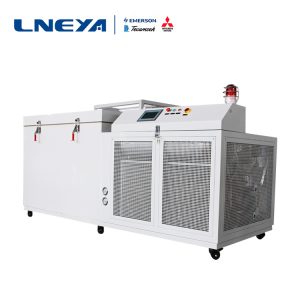How to control the temperature of solvent recovery by distillation?
1. If the product quality is not affected by the presence of air at a higher temperature, it can be recovered at normal pressure first, and when the temperature exceeds the normal pressure boiling point of the desolvent by 10 degrees, when the solvent cannot be evaporated, change the receiving bottle, and then reduce Pressure, the degree of vacuum rises slowly from -0.01mpa to the maximum according to the flow rate. Continue to keep for 0.5 hours until no liquid flows out.
2. If the product quality is affected by the presence of air at a higher temperature, you can first evacuate to the maximum, and then slowly heat up to a temperature 10 degrees higher than the normal pressure boiling point of the desolvated according to the liquid outflow speed. Continue to keep for 0.5 hours until no liquid flows out. However, if you want to recover the solvent in this way, it is best to cool the receiving bottle and condenser with ice water.
From the perspective of process design, it is necessary to fully understand the physical parameters of the materials involved in the process, and adopt a reasonable distillation method and heating medium. The selection of the distillation method is considered from the boiling point and range of the solvent. High boiling point materials When dealing with materials that are difficult to volatilize (boiling point above 150°C under normal pressure), vacuum distillation should be used; for medium volatile materials (boiling point under normal pressure is about 100°C), atmospheric distillation or reduced pressure should be used. suitable. In order to consider reducing the risk in extreme cases, that is, the continuous heating condensation fails and the system is closed, it is best to use hot water as all heating media if conditions are met. (for batch distillation)
In pharmaceutical and chemical industry, we may have heard such a process description, that is, “concentrate to dryness” and concentrate to “paste”; There is a “dry pot” situation.
For batch distillation and concentration, the following methods are usually adopted to reduce the risk of the process:
Control temperature: choose the heating medium with the highest temperature lower than the decomposition temperature (it is recommended to obtain the decomposition temperature through DSC test or ARC test, and the test sample should be representative, which is also the most effective source of safe operating temperature); vacuum distillation instead of normal pressure Distillation (lower distillation temperature);
When recovering waste liquid or solvent, choose continuous distillation instead of batch distillation.
Select the appropriate distillation equipment, some impurities or metal ions can catalyze the decomposition of the material (equipment selection, material should meet the process requirements).
Interlock: prevents ultra-gentle “steam dry”. The high temperature interlock closes the heating medium, and the low liquid level interlock closes the heating medium.
Some of the above content comes from the Internet, if you have any questions, please contact us: sales@lneya.com
Related recommendations
-
How to repair the compressor failure in the industrial glycol temperature cycle machine
1733The industrial glycol temperature machine performs refrigeration and heating reactions under the required process conditions, and the compressor is used as its core accessory. If a fault occurs, the operator should pay attention to summarizing and...
View details -
Working principle of refrigeration and heating thermostat for chemical industry
1577In the selection process of the special refrigeration and heating thermostat for chemical industry, the heating power and the pressure and flow rate of the heat transfer medium are also factors to be considered. Different raw materials have differ...
View details -
Large industrial freezer structural stability instructions
1853Large industrial refrigerators are used in the current industry. In order to maintain a smooth operation, the related structure also needs to maintain a stable state in order to stabilize and operate efficiently. The main structure of Wuxi Guanya ...
View details -
The advantages of water cooled chiller you need to know
1561Industrial chillers can be generally divided into water-cooled and air-cooled according to the type of refrigeration. The heat exchange medium of Water Cooled Chillers is water.LNEYA has designed and developed a new type of temperature control equ...
View details
 LNEYA Industrial Chillers Manufacturer Supplier
LNEYA Industrial Chillers Manufacturer Supplier













